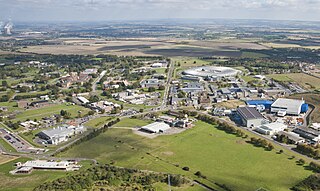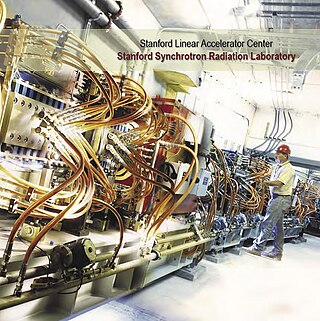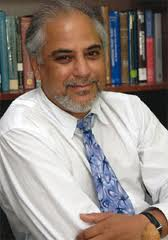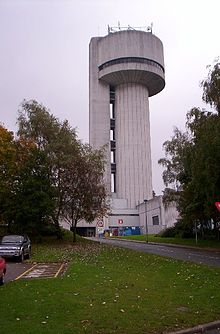
DESY, short for Deutsches Elektronen-Synchrotron, is a national research centre for fundamental science located in Hamburg and Zeuthen near Berlin in Germany. It operates particle accelerators used to investigate the structure, dynamics and function of matter, and conducts a broad spectrum of interdisciplinary scientific research in four main areas: particle and high energy physics; photon science; astroparticle physics; and the development, construction and operation of particle accelerators. Its name refers to its first project, an electron synchrotron. DESY is publicly financed by the Federal Republic of Germany and the Federal States of Hamburg and Brandenburg and is a member of the Helmholtz Association.

SLAC National Accelerator Laboratory, originally named the Stanford Linear Accelerator Center, is a federally funded research and development center in Menlo Park, California, United States. Founded in 1962, the laboratory is now sponsored by the United States Department of Energy and administrated by Stanford University. It is the site of the Stanford Linear Accelerator, a 3.2 kilometer (2-mile) linear accelerator constructed in 1966 that could accelerate electrons to energies of 50 GeV.

A linear particle accelerator is a type of particle accelerator that accelerates charged subatomic particles or ions to a high speed by subjecting them to a series of oscillating electric potentials along a linear beamline. The principles for such machines were proposed by Gustav Ising in 1924, while the first machine that worked was constructed by Rolf Widerøe in 1928 at the RWTH Aachen University. Linacs have many applications: they generate X-rays and high energy electrons for medicinal purposes in radiation therapy, serve as particle injectors for higher-energy accelerators, and are used directly to achieve the highest kinetic energy for light particles for particle physics.

Diamond Light Source is the UK's national synchrotron light source science facility located at the Harwell Science and Innovation Campus in Oxfordshire.

A synchrotron is a particular type of cyclic particle accelerator, descended from the cyclotron, in which the accelerating particle beam travels around a fixed closed-loop path. The magnetic field which bends the particle beam into its closed path increases with time during the accelerating process, being synchronized to the increasing kinetic energy of the particles. The synchrotron is one of the first accelerator concepts to enable the construction of large-scale facilities, since bending, beam focusing and acceleration can be separated into different components. The most powerful modern particle accelerators use versions of the synchrotron design. The largest synchrotron-type accelerator, also the largest particle accelerator in the world, is the 27-kilometre-circumference (17 mi) Large Hadron Collider (LHC) near Geneva, Switzerland, built in 2008 by the European Organization for Nuclear Research (CERN). It can accelerate beams of protons to an energy of 7 tera electronvolts (TeV or 1012 eV).

The Budker Institute of Nuclear Physics (BINP) is one of the major centres of advanced study of nuclear physics in Russia. It is located in the Siberian town Akademgorodok, on Academician Lavrentiev Avenue. The institute was founded by Gersh Budker in 1959. Following his death in 1977, the institute was renamed in honour of Budker.

The Rutherford Appleton Laboratory (RAL) is one of the national scientific research laboratories in the UK operated by the Science and Technology Facilities Council (STFC). It began as the Rutherford High Energy Laboratory, merged with the Atlas Computer Laboratory in 1975 to create the Rutherford Lab; then in 1979 with the Appleton Laboratory to form the current laboratory.
The Research School of Physics (RSPhys) was established with the creation of the Australian National University (ANU) in 1947. Located at the ANU's main campus in Canberra, the school is one of the four founding research schools in the ANU's Institute of Advanced Studies.

The Stanford Synchrotron Radiation Lightsource, a division of SLAC National Accelerator Laboratory, is operated by Stanford University for the Department of Energy. SSRL is a National User Facility which provides synchrotron radiation, a name given to electromagnetic radiation in the x-ray, ultraviolet, visible and infrared realms produced by electrons circulating in a storage ring at nearly the speed of light. The extremely bright light that is produced can be used to investigate various forms of matter ranging from objects of atomic and molecular size to man-made materials with unusual properties. The obtained information and knowledge is of great value to society, with impact in areas such as the environment, future technologies, health, biology, basic research, and education.

The Cornell Laboratory for Accelerator-based ScienceS and Education (CLASSE) is a particle accelerator facility located in Wilson Laboratory on the Cornell University campus in Ithaca, NY. CLASSE was formed by merging the Cornell High-Energy Synchrotron Source (CHESS) and the Laboratory for Elementary-Particle Physics (LEPP) in July 2006. Nigel Lockyer is the Director of CLASSE in spring of 2023.

The ISIS Neutron and Muon Source is a pulsed neutron and muon source, established 1984 at the Rutherford Appleton Laboratory of the Science and Technology Facilities Council, on the Harwell Science and Innovation Campus in Oxfordshire, United Kingdom. It uses the techniques of muon spectroscopy and neutron scattering to probe the structure and dynamics of condensed matter on a microscopic scale ranging from the subatomic to the macromolecular.
The Australian Synchrotron is a 3 GeV national synchrotron radiation facility located in Clayton, in the south-eastern suburbs of Melbourne, Victoria. The facility opened in 2007, and is operated by the Australian Nuclear Science and Technology Organisation.

The Saskatchewan Accelerator Laboratory (SAL) was a linear accelerator facility on the University of Saskatchewan campus in Saskatoon, Saskatchewan, Canada. The facility was constructed in 1962 at a cost of $1.7M under the direction of Leon Katz. SAL was identified by the OECD as a National Large-Scale Facility. SAL provided support for radiology, chemistry and sub-atomic physics research.
The Science and Technology Facilities Council (STFC) is a United Kingdom government agency that carries out research in science and engineering, and funds UK research in areas including particle physics, nuclear physics, space science and astronomy.

The Synchrotron Radiation Source (SRS) at the Daresbury Laboratory in Cheshire, England was the first second-generation synchrotron radiation source to produce X-rays. The research facility provided synchrotron radiation to a large number of experimental stations and had an operating cost of approximately £20 million per annum.

Swapan Chattopadhyay CorrFRSE is an Indian American physicist. Chattopadhyay completed his PhD from the University of California (Berkeley) in 1982.

A particle accelerator is a machine that uses electromagnetic fields to propel charged particles to very high speeds and energies, and to contain them in well-defined beams.

The Helmholtz-Zentrum Dresden-Rossendorf (HZDR) is a Dresden-based research laboratory. It conducts research in three of the Helmholtz Association's areas: materials, health, and energy. HZDR is a member of the Helmholtz Association of German Research Centres.
NINA (Northern Institute's Nuclear Accelerator) was a particle accelerator located at Daresbury Laboratory, UK that was used for particle physics and as a source of synchrotron radiation.

Sci-Tech Daresbury, also known as Sci-Tech Daresbury Enterprise Zone, is a science and innovation campus near the village of Daresbury in Halton, Cheshire, England. The site began life as the Daresbury Laboratory later forming a joint venture and adding the Cockcroft Institute, Innovation Centre, Vanguard House, Techspace One and ITAC. Over 1,300 people work on the campus for nearly 150 high tech companies. The science park was formerly known as Daresbury Science and Innovation Campus. In 2012 it was given enterprise zone status and renamed Sci-Tech Daresbury.


















